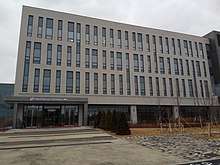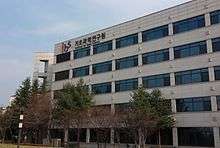Institute for Basic Science
The Institute for Basic Science (IBS; Korean: 기초과학연구원) is a Korean government-funded research institute that conducts basic science research and relevant pure basic research. IBS was established in November 2011 by the Lee Myung-bak administration as a research institute, later be a core of the International Science and Business Belt (ISBB)[2] upon relocation of their headquarters from a rented property to their own campus in January 2018[3] using land reclaimed from the Taejŏn Expo '93 in Expo Science Park. Comprising 30 research centers with 68 research groups across the nation and a headquarters in Daejeon, IBS has approximately 1,800 researchers and doctoral course students. Around 30% of the researchers are from countries outside of South Korea.[1] The organization is under the Ministry of Science and ICT.
기초과학연구원 | |
| Motto | Making Discoveries for Humanity & Society |
|---|---|
| Formation | November 21, 2011 |
| Type | Governmental organisation |
| Purpose | Basic science research |
| Headquarters | Daejeon, South Korea |
| Location |
|
| Coordinates | 36.375959°N 127.385751°E |
President | Noh Do Young |
Main organ | IBS Research Centers |
Budget | 260 million USD (FY2015) |
Staff | 1,800 researchers and students[1] |
| Website | www |
| Institute for Basic Science | |
| Hangul | |
|---|---|
| Hanja | |
| Revised Romanization | Gicho gwahak yeonguwon |
| McCune–Reischauer | Kich'o kwahak yŏnkuwŏn |


In 2011,[4] the Korean government announced an investment of more than 2 trillion KRW (roughly US$2 billion) to build a heavy ion accelerator facility, named RAON, in northern Daejeon by 2021.[5][6][7][8] The facility, if completed on time, is expected to be the world's first device using both the isotope separator on line (ISOL) and in-flight (IF) methods.[9]
From December 2018, the IBS Center for Climate Physics, headed by Axel Timmermann, began to utilize a 1.43-petaflop Cray XC50 supercomputer, named Aleph, for climate physics research.[10][11][12][13]
Organizational Structure
IBS consists primarily of a headquarters (HQ) and secondary units in the form of research centers. IBS plans to establish a total of 50 research centers, employing 3,000 people.[14][15]
IBS research centers are divided into several categories: HQ, campus, extramural, and pioneer research. HQ Centers' research groups are affiliated solely with IBS. Campus Centers are based in the nation's science and technology universities (KAIST, DGIST, UNIST, GIST and POSTECH). Extramural Centers are based in universities other than science and technology universities (Seoul National University, Sungkyunkwan University, Korea University, Yonsei University, Ewha Womans University, and Pusan National University). Pioneer Research Centers (PRC) are headquarters-based centers headed not by a director, but by a group of up to five chief investigators.
As of January 2020, there are 30 centers operating in various fields of science including 6 in chemistry, 6 in life science, 5 in interdisciplinary science, 10 in physics, 1 in Earth science, and 2 in mathematics.[16] The centers are located at IBS HQ in Daejeon and relevant universities in Seoul, Suwon, Daegu, Ulsan, Pohang, Busan, Daejeon, and Gwangju. The annual budget for each center ranges from 2 to US$10 million. Once launched, centers run with no fixed time frame to conduct their research.[15]
There are two affiliated organizations: the National Institute for Mathematical Sciences (NIMS),[17] and the Rare Isotope Science Project (RISP).[18]
IBS Presidents
- Oh Se-jung (November 25, 2011 ~ February 2014) Ph.D. in physics from Stanford University, Professor in the Department of Physics and Astronomy at Seoul National University, and 2nd President of the National Research Foundation of Korea[19]
- Kim Doochul (September 2014 ~ September 2019) Ph.D. in electrical engineering from Johns Hopkins University, Professor in the Department of Physics at Seoul National University, and 5th President of the Korea Institute for Advanced Study[20]
- Noh Do Young (November 22, 2019 - current) Ph.D. in physics from Massachusetts Institute of Technology, Professor in the Department of Physics and Photon Science at Gwangju Institute of Science and Technology (GIST), director of the Center for Advanced X-ray Science, president of Korea Synchrotron Radiation User's Association, dean of GIST College[21]
Educational Programs
IBS School, University of Science and Technology
IBS School is a graduate program jointly founded by IBS and the University of Science and Technology (UST) in Korea.[22] The school opened in September 2015 to foster young scientists in basic science by utilizing HQ Centers' facilities.[23]
IBS Young Scientist Fellowship (YSF)
IBS has been running this program since 2013 to provide opportunities for early career researchers[24] (postdocs with less than 5 years' experience or those under the age of 40 with a Ph.D.) to gain research experience by carrying out independent research within IBS centers.[25]
See also
- Riken
- Max Planck Society
- Korea Institute for Advanced Study
- Facility for Rare Isotope Beams
- On-Line Isotope Mass Separator
- Okinawa Institute of Science and Technology Graduate University
References
- Seijo, Bibiana Campos (October 19, 2019). "Funding basic science in South Korea". Chemical & Engineering News. American Chemical Society. Retrieved October 22, 2019.
- "South Korean research centre seeks place at the top". Nature News & Comment. Retrieved April 1, 2016.
- "Information on Relocation of IBS HQ". www.ibs.re.kr. HQ Relocation Team. December 21, 2017. Retrieved January 17, 2018.
- Kim, Jong Won. Status of the Rare Isotope Science Project in Korea (PDF). LINAC 12. Tel-Aviv, Israel. pp. 455–457. ISBN 978-3-95450-122-9. Retrieved October 2, 2018.
The project is funded and officially started in the end of 2011.
- Beyond Basic Science: Korean heavy-ion accelerator, RAON A major big-science facility of the International Science and Business Belt (PDF). Brochure (English ed.). Rare Isotope Science Project. 2016. pp. 22–23. Retrieved August 8, 2018.CS1 maint: others (link)
- "RISP". risp.ibs.re.kr. Archived from the original on January 17, 2019. Retrieved June 9, 2018.
- www.etnews.com (October 14, 2012). "한국형 중이온가속기 이름 '라온'". 대한민국 IT포털의 중심! 이티뉴스 (in Korean). Retrieved June 9, 2018.
- "Intro. 노벨상 향한 대장정 스타트, 중이온가속기 라온 | d라이브러리" (in Korean). Retrieved June 9, 2018.
- "Korean Government to Invest 2 Trillion Won in Heavy Ion Accelerator". Business Korea. Retrieved April 6, 2016.
- "Institute for Basic Science (IBS) - TOP500 Supercomputer Sites". TOP500. November 2018. Retrieved November 28, 2018.
- Feldman, Michael (September 20, 2018). "Cray Picks Up Two Supercomputer Wins in Asia". TOP500. Retrieved November 26, 2018.
- "Cray XC50 Supercomputer coming to Institute for Basic Science in South Korea". www.InsideHPC.com. September 20, 2018. Retrieved November 26, 2018.
- "PNU's IBS Center for Climate Physics boosts climate research with new Supercomputing Facility". IBS Center for Climate Physics. Institute for Basic Science. Retrieved November 14, 2019.
- Kim, Doochul. "Quantity to quality: How South Korea surged ahead through basic science | The Academic Executive Brief". academicexecutives.elsevier.com. Archived from the original on May 7, 2016. Retrieved August 8, 2018.
- Park, Soo Bin (May 17, 2012). "South Korean research centre seeks place at the top". Nature News & Comment. Retrieved April 1, 2016.
Each centre will have an average annual budget of 10 billion won, and will be directed by a world-class scientist, employed on a 10-year contract.
- "Controlling the messenger with blue light: A new optogenetic tool to manipulate target messenger RNA in living cells". Institute for Basic Science. February 18, 2020. Retrieved February 21, 2020.
- "National Institute for Mathematical Sciences".
- "Welcome to RISP". risp.ibs.re.kr. Retrieved April 4, 2016.
- "History". www.nrf.re.kr. Retrieved May 22, 2017.
- "Former Presidents". www.kias.re.kr. Retrieved May 22, 2017.
- Choi, Jee Won (January 6, 2020). "A warm welcome from the president of the IBS". Institute for Basic Science. Retrieved January 17, 2020.
- "UST University of Science and Technology". www.ust.ac.kr. Retrieved April 4, 2016.
- "UST University of Science and Technology - Introductions Campus". www.ust.ac.kr. Retrieved April 4, 2016.
- Science, ibs, 기초과학연구원, ibs Institute for Basic. "Career | IBS YSF Programs | IBS YSF Program". www.ibs.re.kr. Retrieved April 4, 2016.
- "Research policy: How to build science capacity". Nature. 490 (7420): 331–334. October 18, 2012. doi:10.1038/490331a. ISSN 0028-0836.
External links
| Wikimedia Commons has media related to Institute for Basic Science. |
- Official website (English and Korean)
- Special Act of Establishment of and Support for International Science and Business Belt Korea Legislation Research Institute